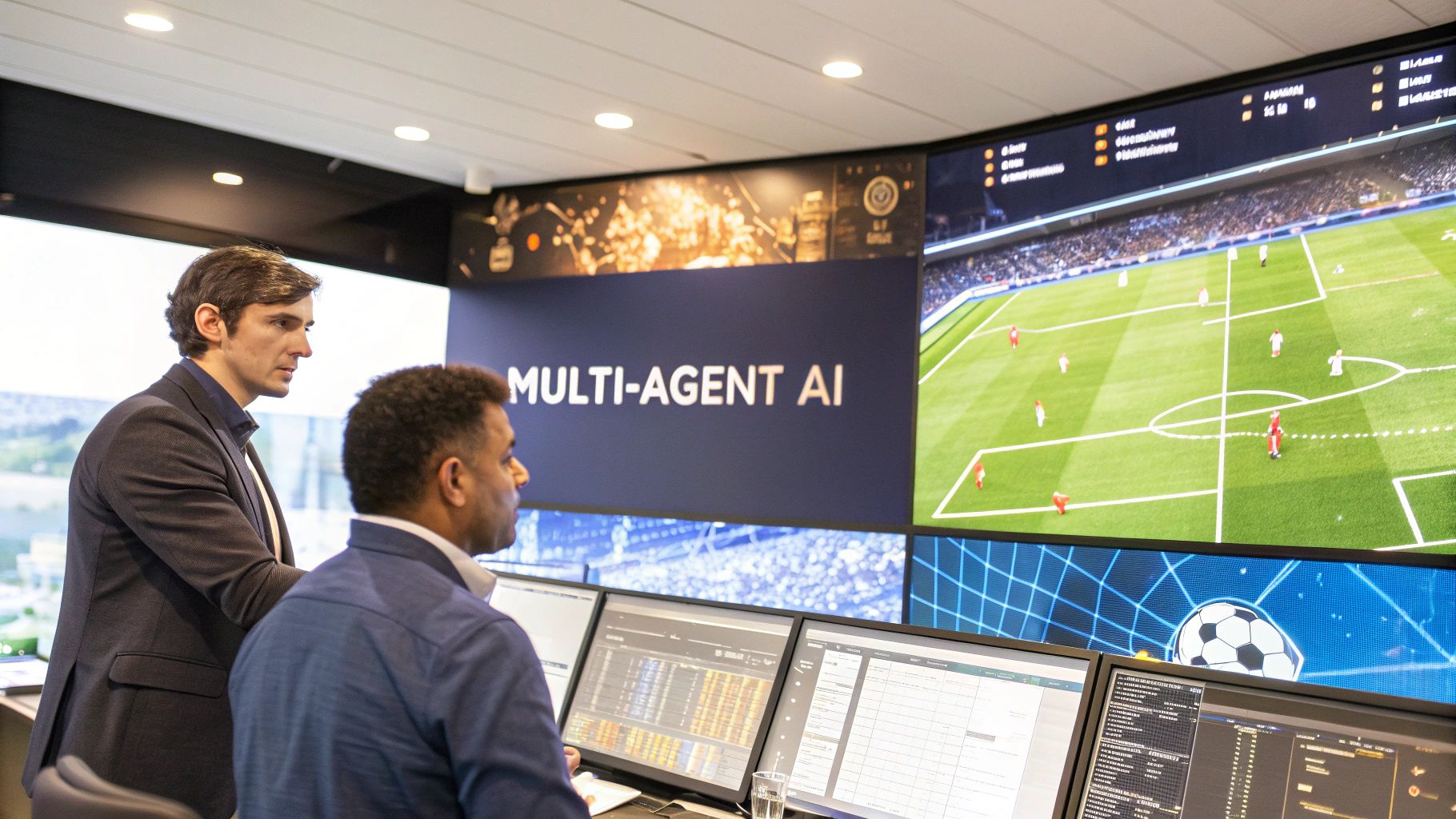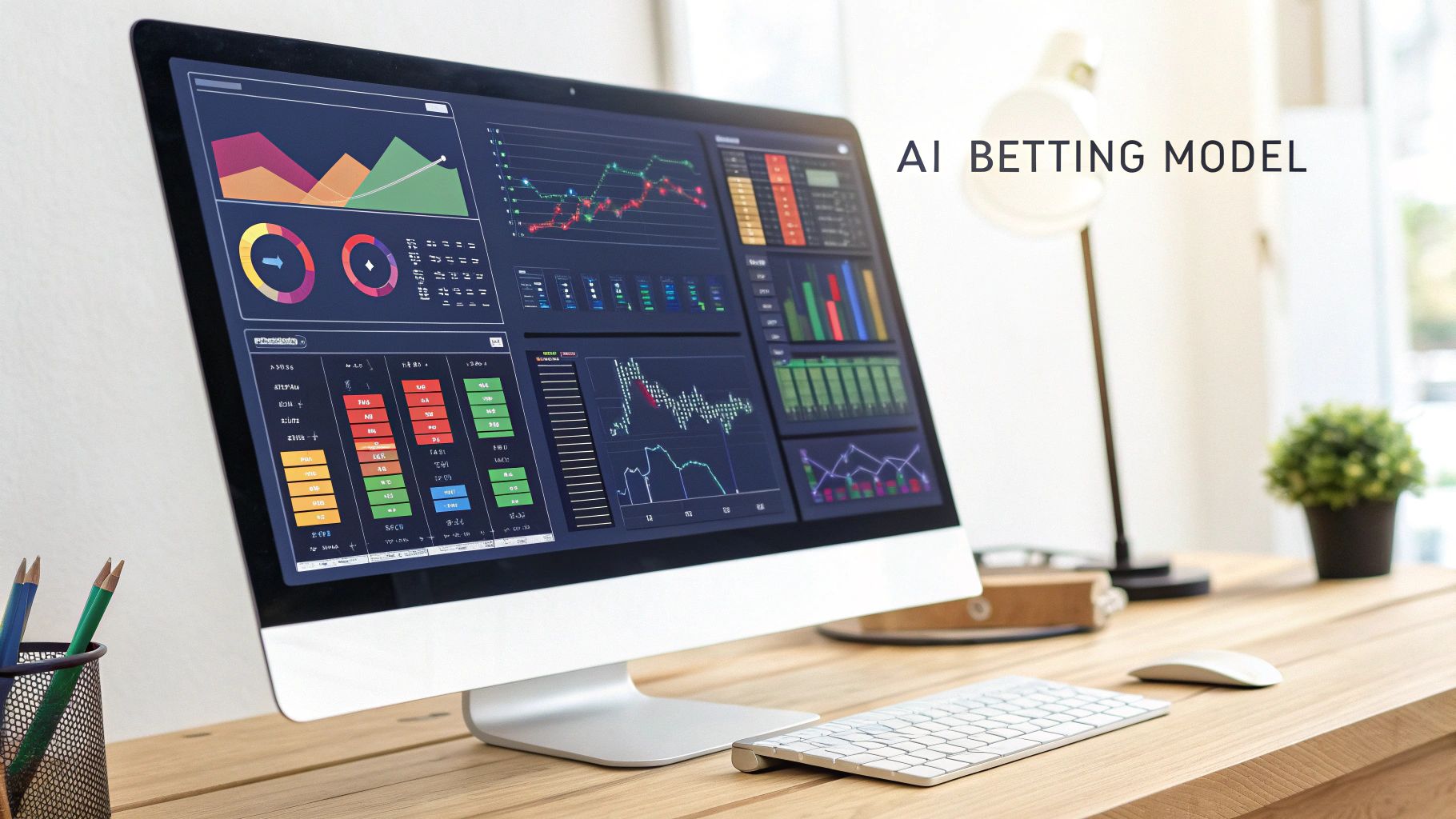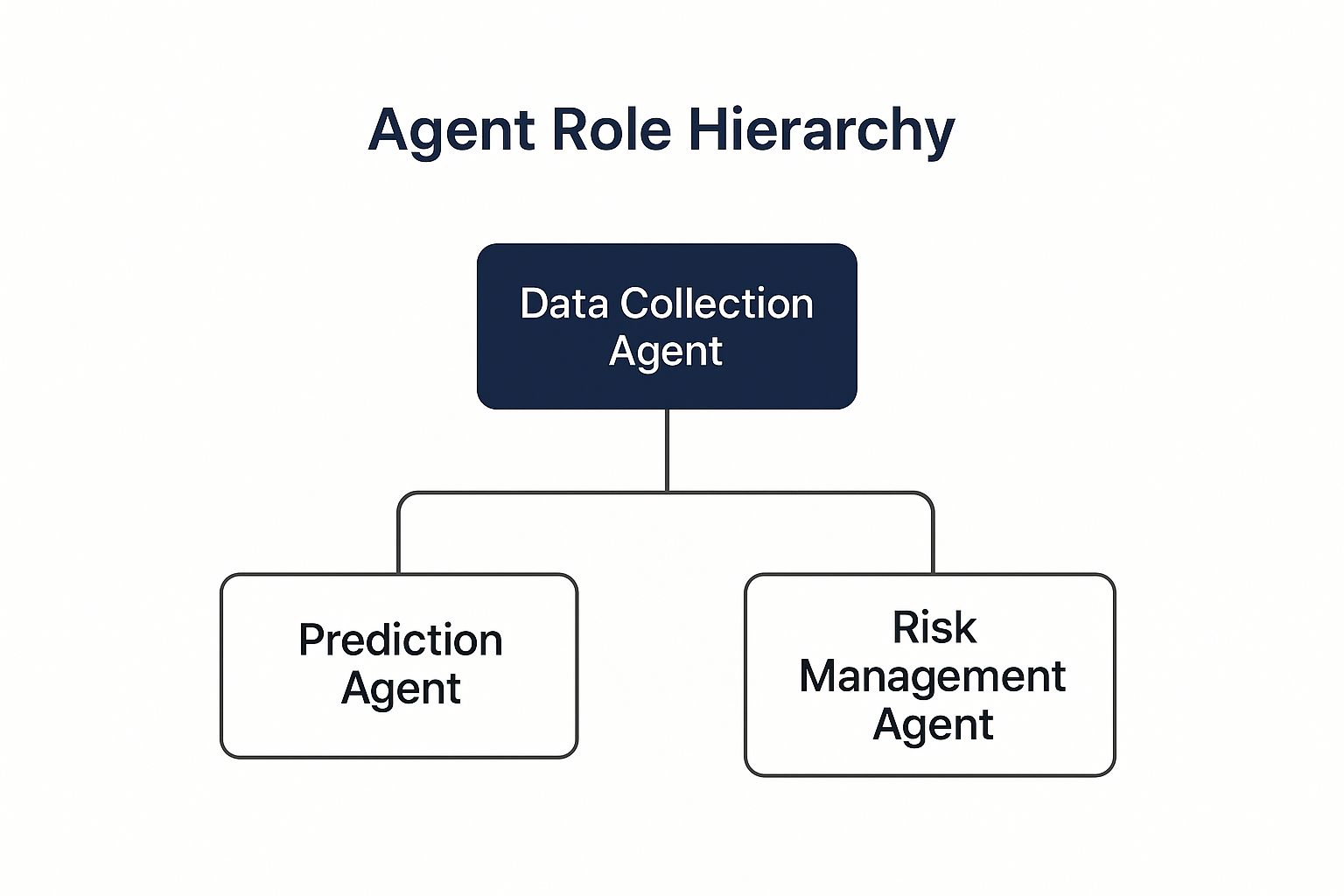
Inside the Multi‑Agent AI Betting Model
Discover how the multi‑agent AI betting model is transforming sports analytics. This guide explains its architecture, real-world impact, and future.
Picture a team of top-tier sports analysts sitting around a table. One is a master of player stats, another is an expert on team tactics, a third lives and breathes historical trends, and a fourth even factors in things like live weather conditions. Now, imagine them working together seamlessly to make one, incredibly well-informed prediction.
That’s essentially what a multi-agent AI betting model does. It’s not just one big algorithm; it’s a team of specialised AIs working in concert to create a forecast that’s far more insightful than any single programme could ever be.
How Multi-Agent AI Is Changing The Game In Sports Betting

Sports betting has always been about finding an edge. For a long time, bettors and bookmakers have leaned on statistical models, but these traditional methods tend to work in isolation. A model might be brilliant at crunching offensive numbers but completely ignore the subtle, yet crucial, impact of a key defender’s last-minute injury. This is where the multi-agent approach completely flips the script.
Instead of a single, monolithic AI trying to do everything at once, a multi-agent system breaks down the problem. It delegates specific tasks to a "council" of expert AIs, almost like assembling a dedicated coaching staff for data analysis. Each AI, or 'agent', has its own job, creating a workflow that feels more like a real-world intelligence operation. This structure is just so much more resilient than putting all your eggs in one analytical basket.
The Power of A Team Effort
This design gets around one of the biggest headaches in predictive analytics: single-model bias. Let’s be honest, any individual algorithm, no matter how sophisticated, has its blind spots. By pulling together insights from multiple, diverse agents, the system can cross-check its findings, weed out oddities, and arrive at a more balanced and dependable conclusion.
A multi-agent AI betting model sidesteps the limitations of a single-model approach. It brings multiple perspectives to the table, filters out bias, and gives a far more complete picture when forecasting outcomes. It's not just about having more data; it's about smarter, more collaborative analysis.
This method gives us a much richer understanding of the countless factors that can decide a football match. For instance, one agent might focus solely on historical head-to-head clashes. Another could be dedicated to tracking current team form, while a third crunches player fitness metrics from the latest training sessions. A fourth might even analyse market odds movements to spot what the ‘smart money’ is doing.
The real magic happens when the system pulls these different viewpoints together into a single, unified prediction. It’s a structure that moves beyond basic number-crunching into something far more dynamic and intelligent. This is what the future of sports betting analysis looks like.
A Look Under the Bonnet: The AI Betting Architecture
To really get to grips with what makes a multi-agent AI betting model so effective, we need to pop the bonnet and see how the different parts work together. It’s less like a single, all-knowing brain and more like a highly organised team of specialists, each playing a distinct and crucial role. This collaborative structure is precisely where its predictive power comes from.
The whole process kicks off with the system's tireless scouts: the Data Ingestion Agents. Their one and only job is to gather colossal amounts of information from an endless list of sources. They never stop, pulling in everything from historical match results and player stats to real-time injury news and even the weather forecast for the stadium.
Once all that raw data is in, it’s passed over to the core analytical team.
Specialist and Consensus Agents: The Brains of the Operation
This is where the Specialist Analysis Agents come in. Think of each one as an expert analyst who lives and breathes a single, specific area. One agent might be a master of offensive tactics, another might focus solely on defensive formations, while a third could be tasked with gauging a team’s psychological state based on their recent form.
This division of labour allows for an incredible depth of analysis. The real magic of these models is their ability to weave together huge, varied datasets. In fact, advanced AI methods have pushed prediction accuracies for three-way football outcomes to impressive new heights, with some models hitting a 55.82% accuracy rate on public data alone, which significantly sharpens betting calibration.
Finally, the Consensus Agent steps up to the plate. This agent is the head coach of the entire operation. It takes the detailed reports from every specialist, weighs all the different perspectives, sorts out any conflicting signals, and synthesises everything into a single, coherent recommendation. It’s the final, actionable betting insight.
The table below breaks down these core components, showing how each agent contributes to the final outcome.
Core Components of a Multi-Agent AI Betting Model
| Agent Type | Primary Role | Example Data Inputs |
|---|---|---|
| Data Ingestion Agent | Gathers raw data from diverse sources. | Historical match results, player performance stats, live odds, team news, injury reports, weather data. |
| Specialist Analysis Agent | Analyses a specific domain of the data. | Offensive/defensive metrics, player form, team morale indicators, tactical formation data. |
| Consensus Agent | Synthesises specialist insights into a final recommendation. | Outputs from all specialist agents, risk analysis, confidence scores. |
As you can see, each agent has a clear, defined role. This structured collaboration is what ensures raw data is systematically refined into sharp, predictive intelligence that carefully balances opportunity with risk.
The real breakthrough of a multi-agent system isn't just processing more data—it's about creating a structured dialogue between specialist AIs. This collaborative approach uncovers insights that a single, monolithic model would almost certainly miss.

This methodical process demystifies how the system works. For a practical look at this architecture in action, you can see exactly how the OddsHaven model works and delivers its daily insights. It’s the synergy between these agents that transforms a sea of chaotic information into a clear competitive edge.
The Data Fuelling the Predictive Engine

Think of a multi-agent AI betting model like a world-class chef. The final dish—the prediction—is only as good as the ingredients used to make it. For these complex systems, the ingredients are massive, varied streams of data that go way beyond simple win-loss records. This is where the model gets its edge, consuming and making sense of information on a scale no human team ever could.
It all starts with a solid base of historical data. We're talking decades of match results, goal totals, and head-to-head records from countless leagues. This gives the AI essential context, helping it recognise long-term patterns and historical trends that often repeat themselves.
But the real magic happens when you dig deeper.
Granular and Real-Time Data Inputs
Modern models thrive on incredibly specific, granular metrics that paint a vivid picture of team and player performance. Instead of just looking at who scored, the system dissects every single aspect of the game.
This includes data points like:
- Player-Specific Metrics: Pass completion rates, successful dribbles, defensive tackles, and even heat maps showing where a player spends most of their time on the pitch.
- Advanced Team Statistics: Expected goals (xG), shots on target, possession percentages, and how well certain tactical formations perform.
- Situational Data: Performance records when playing at home versus away, or how a team typically handles specific defensive setups.
This level of detail is what allows each specialist agent to move past a surface-level view and grasp the subtle dynamics that actually decide a match. Plus, the model isn't just stuck in the past; it’s constantly taking in real-time information to stay completely up-to-date.
A sudden downpour just before kick-off, a star player pulling up with an injury during warm-ups, or a last-minute lineup change are all critical inputs. A multi-agent AI processes this new information instantly, recalibrating its predictions right up until the match begins.
The Human Element: Market Sentiment
Finally, a truly intelligent model also accounts for the human factor by analysing market sentiment. It watches the odds move across major betting exchanges to see where the money is going. A sharp, unexpected shift in the odds can signal anything from insider information to a strong opinion from professional betting syndicates.
By pulling in this sentiment data, the AI gets a crucial layer of insight into market psychology. It’s this combination—historical stats, granular performance metrics, real-time updates, and market sentiment—that creates a complete, multi-dimensional view of every single match.
To see how this all comes together in daily picks, you can explore our full guide on AI-powered football betting predictions. Fusing these different data streams is what gives the system its power to spot hidden value and make predictions with a confidence that isolated data points could never provide.
How Multi-Agent AI Is Shaking Up the Betting World
So, does all this theory actually hold up in the real world? Absolutely. This isn't some lab experiment; multi‑agent AI betting models are already making a serious impact. Sophisticated betting operators are deploying these systems right now to get an edge, especially in the chaotic, fast-moving environment of live, in-play betting. When you need to process and act on new information in the blink of an eye, these models are in a league of their own.
One of the first places you'll see this is in dynamic odds generation. Think about an in-play football match – every goal, penalty, or red card completely changes the game's outlook. A multi-agent system is built for this. Its specialist agents can instantly re-run the numbers after a key event, making sure the odds on offer are a razor-sharp reflection of the match's new reality. For bookmakers, that means more accurate pricing. For sharp bettors, it means a chance to spot value before the market corrects.
Fertile Ground for Smarter Betting
This kind of technology really comes alive in markets with a hunger for digital innovation and a highly engaged online audience. Take Romania, for instance. It’s a perfect example of a market ripe for this kind of disruption.
The sports betting scene there is on a steep upward curve. Revenue is projected to hit around US$256.30 million in 2025, and it’s not slowing down, with an expected annual growth of 4.71% until 2030. This growth is fuelled by a massive shift to online platforms, thanks to everyone having a smartphone in their pocket. If you're curious, you can dig into the numbers on Romania's growing sports betting sector on Statista.
But it's not just about more people betting; it's about them demanding a better experience. As punters get more comfortable online, they expect smarter, more responsive betting options. That’s a demand that multi-agent models are perfectly designed to meet.
You can boil the real-world effect down to two things. For operators, it’s about running a tighter ship—better efficiency, sharper margins, and solid risk management. For bettors, it opens the door to more accurate odds and completely new, data-backed betting angles that weren't even possible before.
Ultimately, this tech is raising the standard for the entire industry. It’s forcing bookmakers to sharpen their pencils and giving savvy bettors the kind of insights that were once out of reach. By taking over the heavy lifting of crunching endless data points, these models let the human experts focus on what they do best: strategy and seeing the bigger picture.
The end result is a smarter, faster, and more dynamic betting market where decisions are driven by data, not just gut feelings. It’s the theory made real, with tangible results that benefit both sides of the wager.
Weighing the Benefits and Challenges
Bringing a multi-agent AI betting model into the fold can give you a serious edge, but it's not a silver bullet. You have to go into it with your eyes wide open, ready to appreciate both its strengths and its very real limitations. The upside is huge, no doubt, but it comes with some genuine complexities you can’t afford to ignore.
Let’s be honest, the biggest draw is the promise of superior predictive accuracy. It's just flat-out better. By getting specialist agents to zero in on specific datasets—one looking at player form, another at tactical clashes, a third on market sentiment—the system builds a rich, multi-dimensional view of a match. This teamwork effectively cancels out the blind spots you’d get with a single algorithm, leading to forecasts that are far more reliable.
This precision is driven by the model's capacity to chew through colossal amounts of data at speeds a human team couldn't even dream of. It can comb through years of historical stats, break down thousands of in-game events, and react to live information in the blink of an eye. This isn't just about being fast; it's about spotting those subtle, profitable patterns that are completely invisible to us.
The Upside of AI-Driven Betting
Beyond just picking winners, these models bring a much more disciplined approach to risk management. You can have one agent dedicated entirely to watching the betting markets for strange movements or flagging odds that seem out of whack with the data. This acts as a vital financial safeguard, helping you dodge costly mistakes and manage your bankroll with more intelligence.
The key advantages really stack up:
- Enhanced Nuance: The system can weigh conflicting signals, like a team with a killer attack but a leaky defence, and arrive at a properly balanced conclusion.
- Adaptability: It recalibrates its analysis on the fly. A last-minute injury or a sudden downpour? The model adjusts immediately, keeping its predictions relevant.
- Scalability: A multi-agent model can analyse hundreds of matches across dozens of leagues at the same time. To do that with people, you'd need an army of analysts.
Navigating the Inherent Complexities
But let's be realistic—tapping into this power isn't a walk in the park. The first major hurdle you'll hit is the sheer computational cost. Training and running a complex multi-agent system demands a massive amount of processing power and access to clean, high-quality data. That translates directly into a hefty financial and technical investment.
Then there's the challenge of actually building and maintaining these things. Getting a team of agents to work together seamlessly, without tripping over each other or spitting out nonsense, is a highly specialised skill. The system needs constant babysitting, fine-tuning, and updating to keep it sharp as the sport and the betting markets themselves change.
The decision to use a multi-agent AI betting model is a trade-off. You gain unparalleled analytical depth and speed, but you must be prepared for the high computational demands and the intricate development process required to make it work.
Finally, the move towards fully automated betting brings up some important ethical conversations. As these models get smarter and more autonomous, we'll need to have serious discussions about accountability, transparency, and the potential for market manipulation.
Multi-Agent AI Betting Models: A Balanced View
Before jumping in, it helps to see the full picture. Here’s a straightforward comparison of what you stand to gain versus the challenges you'll need to overcome.
| Advantages | Challenges |
|---|---|
| Superior Prediction Accuracy: Achieves a more nuanced understanding by combining multiple analytical perspectives. | High Computational Costs: Requires significant investment in processing power and infrastructure. |
| Massive Data Processing: Analyses vast and diverse datasets in milliseconds to find hidden patterns. | Development Complexity: Building, training, and maintaining the system demands specialised expertise. |
| Robust Risk Management: Identifies mispriced odds and helps manage bankroll with data-driven discipline. | Ethical Considerations: Raises questions about accountability and transparency in automated betting. |
At the end of the day, a multi-agent AI betting model is an incredibly powerful tool, but it's not a magic box. The benefits in accuracy and efficiency are undeniable, but they are directly balanced by the very real, practical challenges of putting one into action and keeping it running.
Keeping the Game Fair: Risk Management and Fraud Detection

Beyond just trying to predict who wins or loses, a multi‑agent AI betting model has another crucial job: protecting the entire betting market. Think of it as a team of digital security guards, constantly on patrol for anything that looks out of place. This role is every bit as important as finding winning bets, because it ensures the whole system stays fair and secure for everyone.
Within these systems, you have highly specialised agents whose only mission is to hunt for strange patterns in betting behaviour. They’re like an advanced alarm system, trained to spot the kind of suspicious activity that a human eye would almost certainly miss in the chaos of live markets. When they see a red flag, they raise it instantly, allowing operators to step in and take action.
What Catches Their Eye? Spotting Suspicious Activity
These digital watchdogs aren't just looking for random oddities; they're programmed to recognise very specific red flags that might point to fraud or even match-fixing. The analysis is lightning-fast and incredibly thorough.
Here are a few of the key patterns that set off the alarm bells:
- Unusual Wagering Spikes: Imagine a sudden, massive surge of money on an outcome that seems almost impossible—like a huge underdog to win by an unlikely score.
- Coordinated Betting: This is when multiple accounts, which appear to have no connection, all place the exact same unusual bet at virtually the same moment.
- Atypical Stake Sizes: A brand new account, or one that’s been dormant for ages, suddenly places a bet that is far larger than what you’d normally expect.
This kind of round-the-clock monitoring is absolutely essential. In a growing market like Romania's, this technology provides a powerful line of defence. AI algorithms can churn through enormous volumes of live betting data to catch these blips, doing it far quicker and more accurately than any traditional method ever could. If you want to dive deeper into this, you can find out more about automated betting intelligence on altenar.com.
A multi-agent system isn't just about offence—predicting winners. Its defensive capabilities are a game-changer, safeguarding the market's integrity by identifying and neutralising threats before they can cause significant damage.
This proactive approach to security does two things. It protects bookmakers from potentially crippling losses, but it also protects honest punters from betting in a market that's been compromised. It helps build a more transparent and trustworthy environment where the odds reflect genuine sporting probabilities, not criminal manipulation.
Ultimately, solid risk management ensures every bet is placed on a level playing field. For us bettors, that means we can have confidence in the system, which is just as vital as properly tracking units won and lost for any kind of long-term success.
Your Questions Answered: AI Betting Models
Got questions about how these multi-agent AI betting models actually work? Let's clear up a few of the most common ones.
Is This a Guaranteed Way to Win Bets?
Let's be crystal clear: absolutely not. There's no such thing as a guaranteed win in sports betting, and anyone who tells you otherwise isn't being honest.
The whole point of a system like this is to find a statistical edge. It's about tipping the scales in your favour by digging through mountains of data to find value that the human eye would miss. Think of it as a massive boost to your analytical power, not a magic crystal ball. Football, after all, will always have its glorious unpredictability.
How Is This Better Than a Single Betting Algorithm?
Imagine you're building a team. Would you rather have one star player who's good at everything, or a full squad of specialists—a top striker, a rock-solid defender, a creative midfielder? A single algorithm is like that one star player; it sees the game from one perspective.
A multi-agent model is the full squad. Each "agent" is a specialist AI with a unique job. One might be an expert on analysing player form, another on tactical systems, and a third purely on how market sentiment shifts the odds. They all bring their findings to the table, and a final "manager" agent weighs their different viewpoints to form a single, much more robust prediction.
The real power comes from collaboration. Instead of one AI shouting its opinion, you have a team of specialist AIs debating the possibilities. This dialogue creates a far more nuanced and reliable forecast than any single model could ever hope to achieve on its own.
Can I Get This Kind of Technology for Myself?
Right now, building and running these systems is a massive undertaking. The costs for development, premium data feeds, and the sheer computational power required mean they're mostly in the hands of large betting organisations and specialised tech companies like OddsHaven.
But that doesn't mean you're left out. The insights and predictions from these powerful models are what shape the very odds and markets you see every day. Their work directly influences the betting landscape for everyone.
Ready to see what data-driven decisions look like? Discover daily AI-powered football picks with OddsHaven by visiting https://www.oddshaven.ai.
Ready to Start Winning?
Join OddsHaven and get instant access to AI-powered predictions with an 87% win rate on high-confidence picks
Try OddsHaven Free for 5 Days

